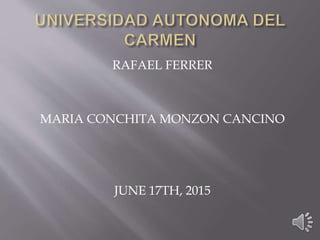Universidad autonoma del carmen
- 1. RAFAEL FERRER MARIA CONCHITA MONZON CANCINO JUNE 17TH, 2015
- 2. computers have become so widespread in schools and homes and their uses have expanded so dramatically that the majority of language teachers must now begin to think about the implications of computers for language learning. It focuses not on a technical description of hardware and software, but rather on the pedagogical questions that teachers have considered in using computers in the classroom.
- 3. ? Though CALL has developed gradually over the last 30 years, this development can be categorized in terms of three somewhat distinct phases which I will refer to as behavioristic CALL, communicative CALL, and integrative CALL
- 4. ? Programs of this phase entailed repetitive language drills and can be referred to as "drill and practice"
- 5. ? Proponents of this approach felt that the drill and practice programs of the previous decade did not allow enough authentic communication to be of much value.
- 6. ? Integrative approaches to CALL are based on two important technological developments of the last decade - multimedia computers and the Internet. Multimedia technology - exemplified today by the CD-ROM - allows a variety of media to be accessed on a single machine.





